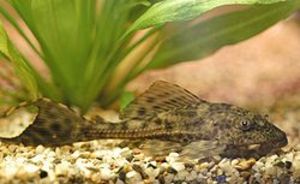“Rena, come look at Mr. Big Fish!” cried my mother. Mr. Big Fish is our adopted 9 inch long common plecostomus. “I think his intestines are falling out!”
I looked at Mr. Big Fish and had to gently break it to my Mom that no, his intestines were not falling out. He was just pooping and pooping normally. Mom rubbed her head in her hands and said, “I have to look at fish poop all day?”
If you are considering a common plecostomus (also called suckermouth catfish or plecos) than please be aware that they poop a great deal. The larger the fish, the more they will poop. Common plecos are usually sold as babies when they are only one or two inches long but can grow to be two feet long.
Normal Pleco Poop
Normal plecostomus waste is tan or light brown, ropey and very long. Your plecostomus can easily produce a long rope of waste twice the length of his body. It may take several minutes for the waste to disconnect from the fish’s body. A pleco is mostly active at night. A still pleco hanging on the side of the tank can sleep, poop and the poop will trail after him for seemingly ages.
Unlike goldfish waste, the waste does not quickly break up into what appears to be silt or powder. The long rope breaks apart into smaller sections which can get caught on aquarium decorations or float around the top of the tank. Again, this is normal. If you can’t handle the poop but want a bottom-feeding fish, try for a smaller species of plecostomus.
What’s The Big Deal?
The big deal about plecostomus poop is that you are going to need to perform more water changes in order to keep the water healthy. You may even need to get a second filter in order to offset the huge amounts of wastes being dumped into the tank water per day. If your pleco lives in a pond, then this will not be such an issue, but even if he lives in a 40 gallon tank, waste will be an issue.
Unless you have a very large (50 gallon or more) aquarium or can make daily partial water changes, you will not be able to keep an adult common pleco with other freshwater fish. The chemicals caused by the decaying waste can kill other fish. Mr. Big Fish currently lives in a 20 gallon aquarium with one male betta (Siamese fighting fish.) I do partial water changes every 2 – 3 days. If Mr. Big Fish grows any more, I will have to purchase a larger aquarium. He’s a lovely fish and I refuse to get rid of him just because he poops a lot.
References
“Freshwater Aquariums for Dummies, Second Edition.” Maddy Hargrove and Mic Hargrove. Wiley Publishing; 2006.
Aquahobby.com. “Common Plecos (Suckermouth Catfish).” http://www.aquahobby.com/gallery/e_Common_Plecos_Hypostomus_Liposarcus_2.php
Author’s personal experience.




